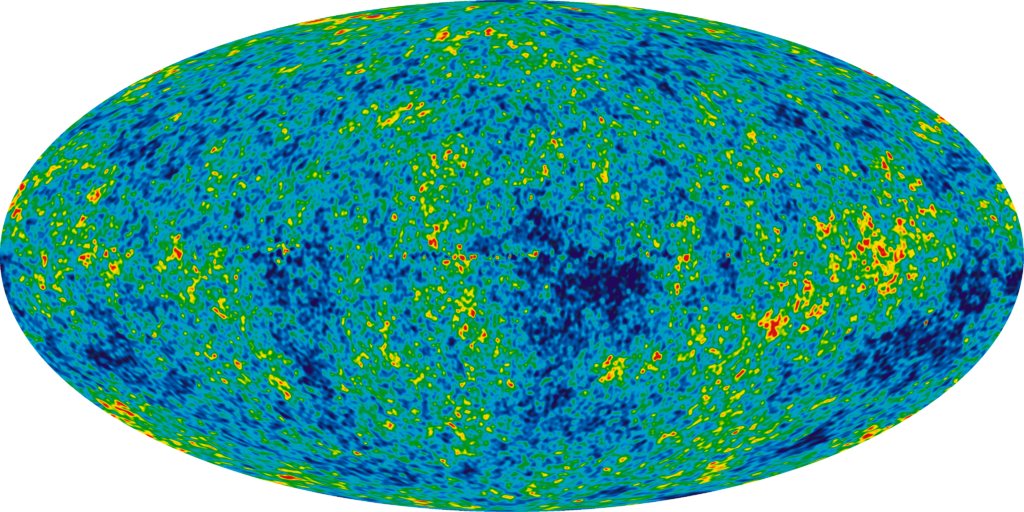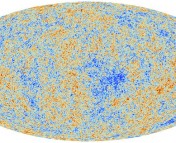Title: To the Center of Cold Spot with Planck
Authors: V.G. Gurzadyan, A.L. Kashin, H. Khachatryan, E. Poghosian, S. Sargsyan, G. Yegorian
First Author’s Institution: Center for Cosmology and Astrophysics, Alikhanian National Laboratory
The oldest light in the universe is the Cosmic Microwave Background (CMB). It comes from a time when the universe was only about 380,000 years old, at the start of a period in cosmological development known as recombination. This was when the universe had finally cooled enough to allow electrons and protons to bind into hydrogen atoms. Before that time, the universe had been a maelstrom of free electrons and protons, which would constantly absorb light and re-emit it in random directions. Once recombination occurred, light could travel freely as long as it didn’t bump into anything. Some of that light never did, and it is still traveling today; the faint glow of the big bang.

Fig 1. The Cosmic Microwave Background as imaged by WMAP over a period of 9 years. The color scheme in this all-sky map shows the minute variations in temperature of the light. The dark blue is colder. The red, hotter. These variations are extremely small. On average, they vary on the order of 1 one-millionth of a kelvin.
This light gives us a way to probe the environment that existed when our universe was young. For example, that light corresponds to a temperature of approximately 2.73 K. That is to say, it looks like it came from an object that has a temperature of 2.73 K (see blackbody radiation). But, there are slight variations in that temperature, as seen in Figure 1. These fluctuations in temperature are described by something called Gaussian statistics. Basically that means the spread in temperatures is described by a bell curve.
There is, however, one large region of the sky that does not fit very well with this Gaussian description: The region known as the CMB Cold Spot. This region appears to be anomalously cold. It is 70 uK (micro kelvin) colder than the average CMB temperature. Most variations are within 18 uK of the average. There is ongoing debate regarding the origin of this cold spot, and several hypotheses have emerged to explain it. One of those hypotheses is that of the Great Void, which suggests that there is a large region of relatively empty space in that direction of the sky. Voids are common in the universe, but to produce this effect in the CMB, this void would have to be exceptionally large: nearly 1 billion light-years across. That’s 1,000 times larger than the typical void.

Fig 2. The top image is a magnified view of the CMB centered on the Cold Spot. The color corresponds to temperature. The bottom image is a K-map, which depicts the randomness in temperature of the same region. The color corresponds to randomness, with blue being low-randomness and red being high-randomness. The white dot in the center symbolizes the center of the Cold Spot. You can see that the center lies in a low-randomness region surrounded by shell of high-randomness, a characteristic common to voids.
The authors of today’s paper present some evidence that support this hypothesis by studying the randomness of the Cold Spot. A characteristic of cosmological voids is that the randomness of their temperature tends to be quite low near the center of the void and grows more random near the edges of the void. The authors made use of what is known as the Kolmogorov-Smirnov test, which computes the degree of randomness across a region of interest. The end result of this process are called K-maps, which map out the randomness associated with a given region of the CMB.
By creating K-maps for a region of the sky containing the Cold Spot (see Figure 2) based on data from the Planck Telescope, the authors were able to show that the Cold Spot existed in a region of low randomness surrounded by a shell-like structure of higher randomness, which is consistent with the idea that the Cold Spot is due to a large void. This does not confirm the Great Void hypothesis, but it certainly supports it. And unfortunately, if the existence of the Great Void is eventually accepted as the cause of the Cold Spot, it will likely raise more questions than it answers. If the Great Void is responsible for the Cold Spot, then what is responsible for the Great Void?





What is the latest explanations on the Planck anomalies?
Soon after the study by Gurzadyan et al the nature of the Cold Spot as a great void has been concluded also via the large scale galaxy survey by Szapudi et al, Monthly Notices of the Royal Astronomical Society, Volume 450, p.288-294, 2015